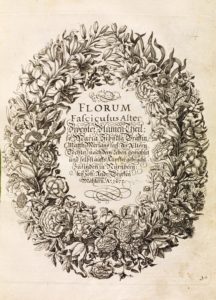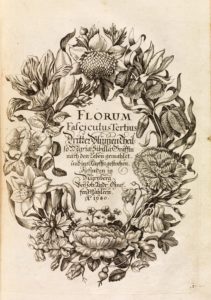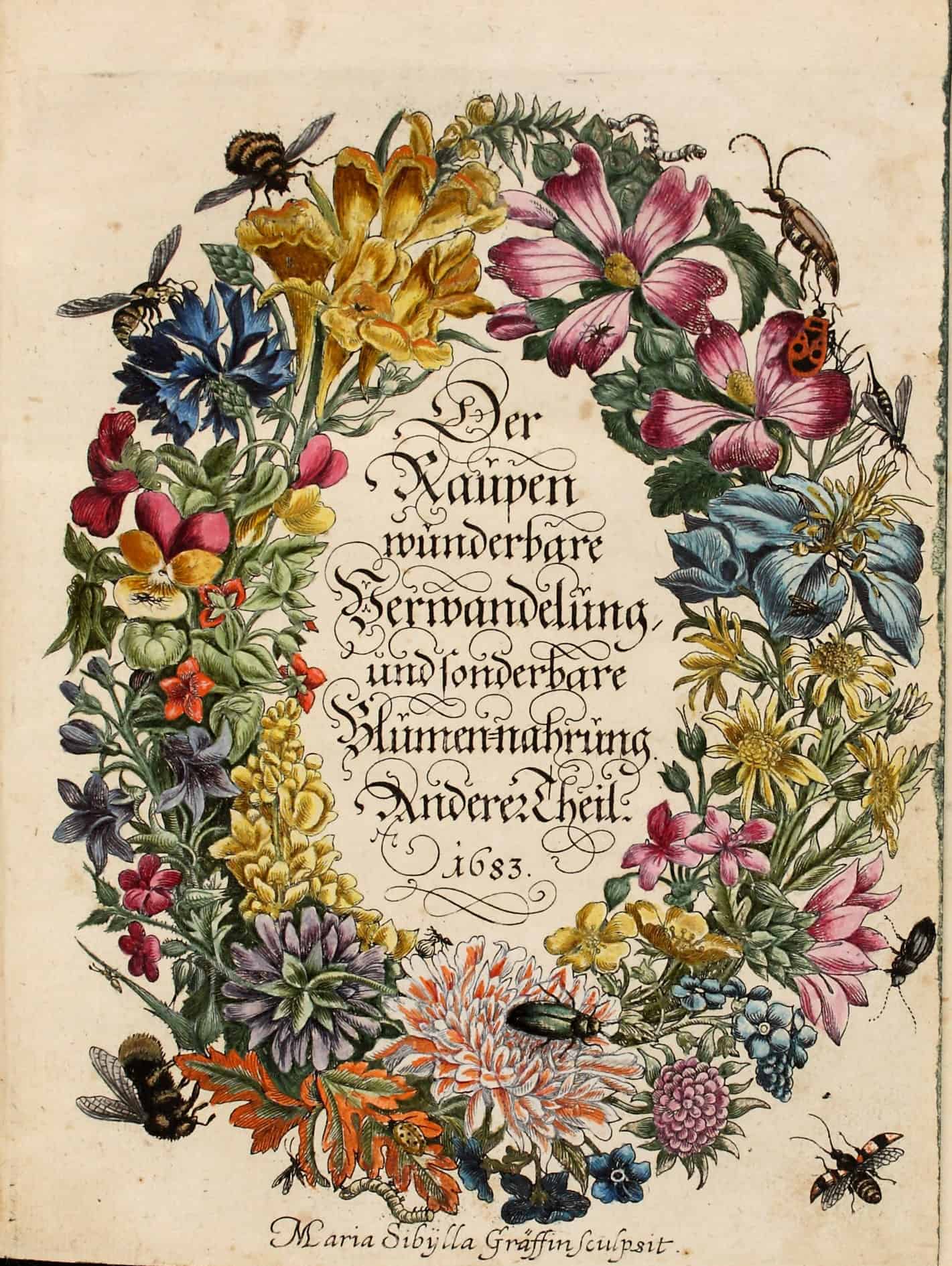OBSERVING – DEPICTING – DESCRIBING
From Maria Sibylla time in Nuremberg date five publications together with her husband. All of them were sold unbound - as a 'loose-leaf collection', so to speak. Her three books of flowers corresponded in style to the prints already offered by Matthäus Merian the Elder in Frankfurt and his father-in-law Johann Theodor de Bry.
The Flower Books
1675: First edition of the “Flower Book” = Florum Fasciculus Primus with 12 copperplate etchings very suitable for illumination and as patterns for embroidery by industrious maidens.
1677: Continuing edition of the “Flower Book”: The demand seems to have been gratifyingly high, so that 12 further copperplates in the Florum Fasciculus Alter were profitable. Success went on.
1680: Florum Fasciculus Tertius contained 12 further copperplate etchings, and at the same time, a package of all 36 etchings was offered as "Das Neue Blumenbuch" (The New Flower Book). (1)
Depending on taste and wallet, the customer could purchase them as a bundle of uncolored sheets or - much more expensive - "illuminated" with colors and entrust them to a bookbinder himself. The Bamberg State Library holds one copy of each of the first three uncoloured editions, which impress by Maria Sibylla's skill as an etcher.
Her great talent for coloration can be admired in one of the few preserved coloured copies of the "New Flower Book" and its three title copper prints in the Dresden State and University Library. According to experts, they were illuminated by Maria Sibylla herself. The comparison of the title copper prints of these editions shows the highest quality of the artist in both techniques.
Title Etchings of the first Editions of the Three “Flower Books” 1675, 1677, 1680 (Bamberg) (2)
New Flower Book, three Parts with three Title Etchings 1680 (Dresden) (3)
The Caterpillar Books
Maria Sibylla left the usual paths with her caterpillar books, which she devised, etched and wrote text for which was set by a Nuremberg printer. Her new copperplate etchings show the development (metamorphosis) of insects, starting with eggs and then via caterpillars and chrysalis through to butterflies or beetles and other insects, together with the respective host plants the caterpillars feed on. This representation of non-simultaneous things on the same page had to be explained, so Maria Sibylla supplemented each illustration with an extensive description on a separate page – she thus became a non-fiction author with a novel combination of text and image on the topic of insect research (entomology).
First Caterpillar Book 1679: “On the Caterpillars’ Miraculous Metamorphosis and Special Flower Nourishment"
On the lower ends of the mulberry branches framing this title – almost hidden – is written:
Mar-Sibill Gräffin / geb: Merianin
There is no Latin text in the Caterpillar Book, everyone was to be able to understand her clearly worded and uncomplicated texts accompanying the 51 copperplate etchings (with title etching), including her female pupils from the “Company of Maidens”.
In the foreword, she directly addresses the “Highly Revered Art-Loving Reader” and for the future promises “… to continue industriously with drawing from nature: and further I intend / for each species / with the well-provided support of my spouse / to add their foods drawn from life". (4)
The mention of help, in particular in adding the plants (“the foods drawn from life”) on the drafts, is a great exception in the work of Maria Sibylla. If she gives us any insight into her work and life at all, she almost always words this in the first person. Astonishingly, she will later on even keep silent about her younger daughter accompanying her on a 2-year expedition to Surinam, although she was her most important collaborator and although the seriously ill mother would hardly have survived the long and arduous sea voyage back to Amsterdam without her daughter’s help.
She kept her promise of making further insect observations, and only 4 years later, her second Caterpillar Book was published, again by her husband:
Second Caterpillar Book 1683: “Second Part of the Caterpillar’s Miraculous Metamorphosis and Special Flower Nourishment”
Below the splendid flower wreath she names herself as copperplate etcher: "Maria Sibylla Gräffin sculpsit“
These 51 further etchings (without texts) were probably also printed in the house “on the Milk Market”. For some of the prints show careful attention during the printing process which would have gone far beyond the practices of other commercial printers. Erlangen University Library owns very rare “counter prints” of the First and Second Caterpillar Books, which were made by a special printing process, not directly from the copperplates, but by pressing the still wet printed paper onto a second, also wet sheet of paper.
Maria Sibylla valued these counter prints, particularly because of their fine contours, as a basis for illuminating. At the time, this counter print process was not widely used. It required great care and a particularly well-balanced composition without any text, because the results of the printer’s press are always mirror images.
THE NUREMBERG BOOKPRINTERS
The text sections were farmed out to two different printers who had both immigrated to Nuremberg, but had completely different starting points. They are a good example of the wide range of opportunities and risks for immigrants in the last decades of the 17th century:
Caterpillar Book 1: Printed by Andreas Knortzen / 1679
Knortz came from Kulmbach, and for several years tried in vain to get permission to establish his own print workshop (= Offizin) in Nuremberg; it was only when the Imperial Court in Vienna accepted his application and set an ultimatum for its implementation, that the Nuremberg Council abandoned its resistance to this unwanted competitor to local printers and after late 1676 permitted him to print. The Council, however, did not like some of his printed products (such as one about the Teutonic Order of Knights or one about an English fortune-teller), and some were confiscated and Knortz was also punished with short terms of imprisonment in a tower.
So the printing contract by Graff and Gräffin for a book which could not offend religious feelings was probably very welcome in this difficult start-up period. After Knortz’ death, his widow and his son continued the print workshop for over 20 years. (8)
Caterpillar Book 2: Printed by Joh. Michael Spörlin / 1683
Merianin literature mostly assumes that the Second Caterpillar Book was printed in Frankfurt, because, in 1683, the Graff-Merianin family had already moved to Frankfurt. But as matter of fact, the Spörlin workshop was in Nuremberg, and this is where the printing of the texts took place. (9)
Spörlin, son of a Frankfurt printer, came to Nuremberg, and in 1682 married the widow of a Nuremberg printer. This was the easier method for an immigrant to acquire his own workshop; Clearly Spörlin did not have the same difficult start as Knortz. The Council and professional competitors usually allowed journeymen, who married a master’s widow and thus provided for her, to continue the master’s workshop. Widows were even permitted to manage a workshop for some time, if there was the prospect of a son as the father’s successor – as was the case with Spörlin’s second wife who married the widower married and who survived him. (10)










